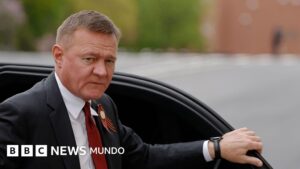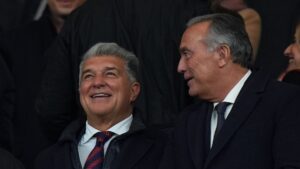After the collapse of the Bashar al Asad regime in December 2024, it was predicted that the Islamic State (EI) could be reborn from its ashes in the midst of power vacuum in Syria – where the group controlled large territories for several years. Although the new authorities have wanted to send a message of tranquility to the world – and specifically to the West – about the presence and activity of radical groups on Syrian soil, the IS has significantly increased their attacks and other terrorist groups are very active in the country.
Last May, when President Donald Trump met by surprise with his Syrian counterpart, Ahmad al Sharaa, in Saudi Arabia, asked precisely to expel all the “foreign terrorists” of Syria and help the United States to prevent the Islamic State from resurfaceing in the Arab country, according to the White House at that time. This week, the US president has signed an executive order raising the sanctions to the country.
Not only the so -called Daesh represents a concern, but other radical combatants who for years fought in Syria against the regime, even in the ranks of the Islamist group that led Sharaa, Hayat Tahrir al Sham (HTS). Many of HTS militiamen have been integrated into the new Syrian security forces after the armed group led Damascus last December, but several months later it is still a challenge for the new government the presence of thousands of radical foreign combatants who went to Syria to fight the Asad – in the past more than ten years, those men have married, they have had children and have been based in the country.
Increased terrorist attacks
On June 22 there was the largest suicide attack from the regime's fall to date. An attacker agreed to the Church of Mar Elías in Damascus and opened fire against the parishioners; He subsequently detonated his explosive vest, killing 25 people and hurting another 63, according to the official count. The Syrian authorities held the jihadist group Islamic State (EI), although another recently created radical group was the one that assumed the authorship of the attack: Saraya Ansar al Suna.

The Syrian Interior Ministry announced a few days after all cell members who planned the attack were arrested and weapons and explosives were also seized. According to The version of the Ministry of Interior, The cell was led by a Syrian citizen, who facilitated the arrival of the suicide attacker (of non -Syrian nationality) to Damascus from the infamous camp of Al Hol, which houses thousands of relatives of members of the Islamic State in the northeast of the country.
The acledge organization (Armed Conflict Location & Event Data), which collects and analyzes conflict data worldwide, has counted at least 13 attacks against Christian citizens and their properties. The attacks have been perpetrated by several actors, including the new Syrian authorities.
On the other hand, ACLED has registered about 50 attacks by the Islamic State between May 1 and June 23, 2025. In May, they increased more than double compared to April, reaching almost 40, the highest monthly figure since the fall of the Al Asad regime five months before. In addition, the IS assumed in May its first attacks against the new authorities.
The chief researcher for the Middle East of Acledge, Muaz al Abdullah, emphasizes that there is “a continuous risk of sectarian violence in the Syrian transition, which extends beyond the Christian community.” The Alauí community (a branch of Islam to which it belonged to the Asad) has been the most beaten by far from the regime's fall.
Regarding the attack against the Church of Mar Elías, claimed by Saraya Ansar Al Sunna, Al Abdullah believes that “although it was directed against a specific group of Syrian society and a religion in particular, it had as white at the same time the new Syrian government. The expert explains to Eldiario.es that the objective is to” undermine the efforts to build a new state after the fall of the regime of the regime and present to Fragile and weak entity, unable to achieve civil and social stability. Therefore, its main objective is the emerging Syrian state. ”
The Abdullah emphasizes that, in addition, the attack puts the focus on “a topic of special importance in the West: the question of minorities.” Precisely, Saraya Ansar al Sunna has declared that his main objectives in Syria are minorities. The expert adds that this radical Sunni group has not openly declared its loyalty to the Islamic State, but a connection between both groups cannot be ruled out. “We have seen similar scenarios with organizations that operated mainly under the Islamic State without (having declared) an explicit loyalty” to this group.
The last movements of the IS, with the increase of their actions in Syria since May, “reflect an adaptive response to a stricter surveillance and the greatest pressure of the Syrian and international forces,” he tells Abdullah in reference to both Syrian authorities and the Kurds, fighting EI with the support of the United States. The analyst states that the group remains much weaker than during its boom between 2014 and 2017, when it established its caliphate in Syria and Iraq, but we must not forget “its constant ambition to recover its relevance and disturb the fragile political transition (before) the risks facing the emerging political order of Syria”.

Foreign jihadist combatants
That political order is also threatened by the presence of other armed actors. A recent report of the Soufan Analysis and Research Center (with headquarters in the US) on foreign combatants in Syria warns that transition developments in the Arab country will have long -term implications, not only at the local level, but for “the panorama of the terrorist threat in general.”
The foreign combatants (among which there are Uigures, Albanses, Uzbekos, Tayikos, Russians, Turks, etc.) acquired a great experience in the Syrian civil war and taught their local partners to fight against the forces of the regime, explains the report. Now they can be fundamental in the formation of the new Syrian army, but also “must be monitored” because they could have “future objectives outside Syria,” the Soufan center warns.
Those combat groups – of which the report excludes the Islamic State and Al Qaeda – “are not only highly trained, but are also strongly motivated ideologically and religiously.” In addition to cooperating with each other, they have also collaborated closely with HTS and other Syrian groups, and participated directly in the offensive that the rebels launched in November last year in the northwest of Syria and ended up overthrowing the regime in Damascus.
“Many of the foreign combatants in HTS ranks have been in Syria for many years; some have married Syrian women and had children during their stay in the country. If these people do not join the Syrian Armed Forces, they could join Al Qaeda or the Islamic State,” the report says. “There is also the very real possibility that if they are abandoned, those foreign combatants could become against the Syrian interim government itself, destabilizing the country at a crucial moment.”
“For jihadist groups and their foreign allies, the Syrian Operations Theater has been a scenario to train and acquire experience, a crucial step to expand the jihadist struggle to other theaters of operations,” says the Soufan Center. Now that the war in Syria has ended – although the report includes that the groups continue to publish photos and videos of their military training in the country -, the objective they have is to “return to their countries of origin and fight to free their land from those whom they consider oppressors”, just like before they fought against the Asad.
Recently, the US gave the green light to the integration of some foreign combatants in the Syrian army, in a division created specifically for them, together with Syrian soldiers, after Trump asked Al Sharaa to his expulsion from the country. The expulsion of thousands of combatants, mostly jihadists, is not feasible for the Syrian government and would generate instability both in the Middle East and in their countries of origin.
USA and Democratic Syrian forces
Washington has played an outstanding role in the fight against IS in Syria for a decade and has had an ally on the ground: mostly Kurdish militias called Syrian democratic forces (FSD). The FSD operate in the northeast of the country, where the Kurds established their self -government during the civil war. Since the fall of the regime they continue to act against the IS and manage the centers of dention of ex -combatants and their relatives, such as the Al Hol camp.

The US troops deployed in the northeast of Syria have begun to retire since Trump returned to the White House last January. The Trump administration said in June that it would reduce its military presence from eight to a single base in Syria (all in the region controlled by the FSD).
The commander of the FSD, Mazloum Abdi, told the Reuters news agency that “the threat of the Islamic State has increased significantly recently” and that a few hundred US soldiers will not be enough to deal with that threat. “This is the American army plan. We have known it for a long time … and we are working with them to ensure that there are no gaps (security) and that we can maintain pressure on the Islamic State,” he said.
Abdi assured that EI cells have reactivated in several Syrian cities, including Damascus, and that a group of foreign jihadists who fighting the Syrian regime have joined their ranks. He also pointed out that in the midst of chaos after the fall of the regime, extremists were made with weapons and ammunition of the armed forces of Al Asad.
The Muaz analyst at Abdullah says that there are “many sleeping cells” of the IS in Syria that can act in different parts of the country, but the group “currently cannot launch a great recruitment campaign or attract new combatants to their ranks.”






